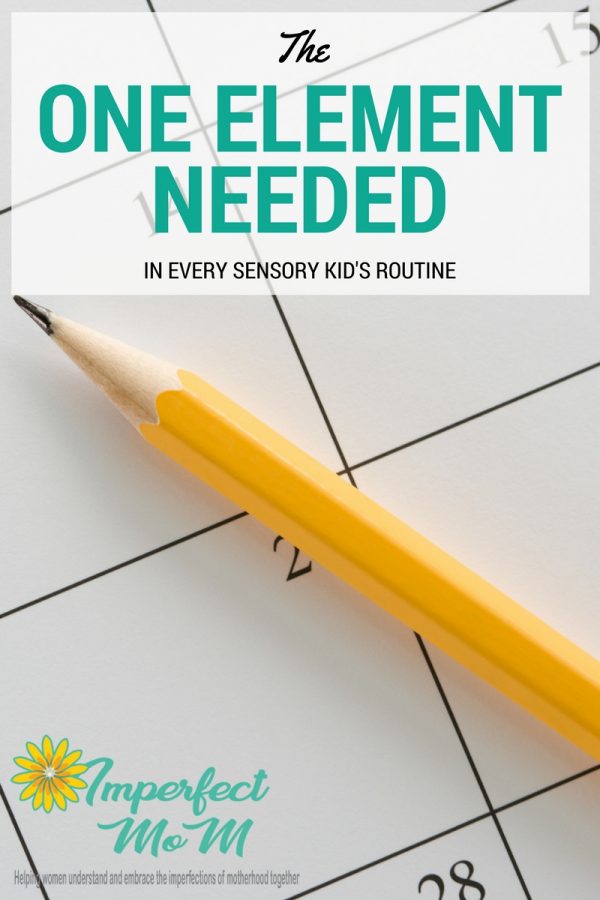The One Element Needed In Every Sensory Kids Daily Schedule
If you struggle with the morning routine for your sensory kid, this one element is an absolute MUSt in your kids daily schedule!
Be sure to learn more about Sensory Processing Disorder and my parenting tips on how to support your child with sensory challenges.
The One Element Needed In Every Sensory Kids Daily Schedule
My son woke up Tuesday morning with a scowl on his face, yelling at his sister for sitting in the wrong spot on the couch, and cursed Netflix for apparently deleting his favorite show.
The rest of the day looked pretty similar, nothing was “perfect” everything was “stupid” and there wasn’t much that anyone could do about it.
Wednesday, however, was a beautiful day. He woke up with a smile on his face, ready to give me a hug.
The first words out of his mouth were “I’m so happy Netflix is working today!” (by the way, it hasn’t ever “stopped” working!)
He was calm, thoughtful, reasonable, and absolutely a dream.
The difference?
Aside from trying to guess that the stars were all in alignment, the earth was apparently spinning on its axis again, or the happy gnomes needed to visit him more often, the answer lies in a something much more tangible.

The World for A Sensory Kid
The world can be a very disorienting, bombarding, stressful place for any child, but especially a child with sensory differences.
Different stimuli are constantly bombarding sensory kids who are over registering or under registering everything around them and working hard to bring themselves back to self-regulation.
Doing this constantly throughout the day takes a lot of energy and mental preparation, leaving little room for flexibility and spontaneity.
A new environment can bring in new stimuli that may not be dealt with easily, by implementing a clear schedule, set routines, and allowing time for transitions, a child has time to prepare for any changes and knows what will be expected of him.
After reading this it all made sense!
My child needs to have more control over his environment.
That ONLY happens when things are predictable.
Predictability comes in many different forms, and thankfully can happen in a number of different ways.
Depending on the preferences of your home, you can choose which of these will be most helpful to establish a less surprising environment for your child.
Simple Routines
Routines help all of us know what to expect, especially in a kids daily schedule.
It also is a great way to practice certain skills or tasks that need to be part of the day.
If my kids are struggling with something, we turn it into a routine.
For example, they were having a hard time getting ready for bed on time.
So, we turned it into a routine that worked for everyone.
The formula I like to use is the following:
- State clear expectations (keep them simple, no more than 5)
- State a goal or reason for the activity
- State a clear beginning and an end
For our night time routine we do the following:
- Night time snack with a reminder that it is close to bedtime
- Kids go upstairs, get pajamas and bush teeth while parents clean up
- As soon as kids can show they are done, story time begins
- After stories each kid gets a snuggle and it’s time for bed
- After that my oldest reads quietly until his body is tired
For us it works because there is a flow to it. We do the same things every night. For the most part, it works (nothing is ever perfect).
Related Post: How to Create A Successful Sensory Morning Routine Your Child Will Love
Your Kids Daily Schedule
My son LOVES knowing his schedule during the day.
Before implementing a clear schedule, he would frequently ask me about what we were going to do today, what was going to happen next, etc.
I would always answer his questions, but too often it was too late (in the car on the way to the store) and he would freak out.
To prevent those meltdowns, we have changed things a little so he is more aware of his schedule.
I take time at least three times every day to talk about our schedule.
When he wakes up I sit with him, give him a bear hug and talk about our morning.
In the car on the way home, (in the afternoon) we talk about the afternoon events.
Before he goes to sleep I snuggle him up in his favorite blankets and we talk about the events of the next day.
I like talking to him when he is “snuggled up” or strapped in, because he is getting a little extra dose of “feel good” (proprioceptive input) while we talk about the things we will do. It is such an easy thing to do, but the effects on him are amazing!
Knowing his schedule seems to give him a sense of empowerment, as if he has control over that one particular event and can handle it.
He rarely asks me now what we are going to do next because I am reminding him often enough that he doesn’t need it.
Personally, we do verbal reminders in our house, as I am HORRIBLE at sticking with any kind of chart.
As a former special education teacher, however, I do know that most kids prefer visual schedules (I DID use them when I was teaching).
I found a user-friendly website where visual schedules can be created here, for those who want to do them.
Transition
I watched a mom the other day who was dropping her son off at daycare.
She said “I am leaving now, I love you, after a while crocodile” then gave him a kiss.
It was cute and her son engaged in it, but then she next to him and repeated it at least five times.
By the time she got up and left, he threw a fit, screamed, and tried to block her from leaving.
There was a breakdown in her transition which created an unpredictable situation for her son who then threw a fit.
A successful transition needs to have the following components:
1. A clear beginning (time limit)
2. Clear expectations
3. Closure
Using that same situation the mom could have, pulled up to preschool, told her son that she would:
1. Walk him to class (beginning)
2. Help him sit at his chair (expectations of her)
3. Tell him goodbye (expectations of her)
4. Give him a kiss (expectations of her)
5. Leave (closure).
Having her son hold up his fingers and repeat back to her the steps of what would happen before walking in to preschool would also help with the transition.
Then as they walk to preschool they could verbally go through the steps again if needed.
The mother’s responsibility, then is to follow through with those steps exactly as planned.
Any variation from it could upset the child or cause a meltdown (as it did in the original scenario).
Being proactive and implementing three simple things into our daily schedule I have found my son to be much more at ease in his environments.
Instead of waiting for all the stars to align and hoping for a great day, with this concept I can be more proactive to help create more good days for my child with sensory differences.
As an added bonus, we all are a little happier!
About the Guest Author
This post originally appeared on WendyBertagnole.com and is reprinted with permission.
With an undergraduate degree in child development, and a master’s degree in special education, this foundation was a springboard for Wendy in helping kids and families to see the root of any challenges they face.
